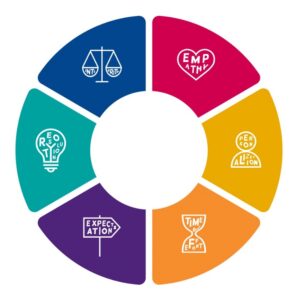15.02.24
Customer experience in the driver’s seat of insurance transformation

Our expectations are driven by the GAFAMs
Technology has entered our lives and is shaping our expectations. In an ever more connected world, the rise of the big tech platform has accustomed us to seamless interactions and responsive operations. Tech giants such as Facebook, Linkedin, Instagram, Google, and Amazon are dictating the way forward. Users now expect and seek the same instant and convenient interactions from all other service providers. Due to entry barriers and traditionally lower touch points, the financial service industry did not react at once. A growing gap between customers’ aspirations and the services offered by traditional insurers has favoured the appearance of new players; technological enablers and neo-insurers. While the neo-insurers concretized a direct threat to their client base, the technological enablers offered innovative technology to better satisfy customers, improve their experience, and better defend themselves from neo-insurers.
In an industry where a big part of interactions between customers and insurance companies were traditionally face-to-face, the remoteness imposed by Covid turned even more dire the need for insurers to provide a new customer experience that is as satisfying or more than before.
What makes a good customer/user experience
The overall experience a user or client has relative to a product or service results from a series of factors.
Don Norman, considered the inventor of the term “User Experience” when he worked for Apple in 1993, believed that products that provide a great user experience (e.g., the iPhone) are designed with the product’s consumption or use in mind and the entire process of acquiring, owning and even troubleshooting it[i].
The International Organization for Standardization (ISO) defines user experience as: “A person’s perceptions and responses that result from the use or anticipated use of a product, system or service.” [ii]
KPMG conducted further research to identify the underlying characteristics of a world-class experience and concluded they amounted to 6. The Six Pillars of customer experience excellence are universal qualities that they found to be present in every outstanding customer relationship[iii].
According to KPMG, these Six Pillars of Experience have consistently been the essential characteristics of world-class experiences. The presence of these six factors is essential if commercially beneficial behaviors are to ensue because of customer experience. Whether it is an increased share of wallet, loyalty, or advocacy, KPMG supports that these six factors are the prerequisites for commercial success. Companies need to be good at them to succeed.
The Six Pillars of Customer Experience Excellence, by KPMG

Personalization
Using individualized attention to drive an emotional connection
Integrity
Being trustworthy and engendering trust
Expectations
Managing, meeting, and exceeding customer expectations
Resolution
Turning a poor experience into a great one
Time & Effort
Minimizing customer effort and creating frictionless processes
Empathy
Achieving an understanding of the customer’s circumstances to drive deep rapport
Keeping these Six pillars in mind when thinking about process improvement in any part of the insurance value chain is essential. Aiming for excellence on each of them will help increase customer satisfaction metrics such as Net Promotor Score (NPS) or Customer Satisfaction (CSAT) score.
Customer experience driving operational change
Technological innovation and improvement drive customer expectations, which in turn nurtures R&D that leads to new technological breakthroughs which insurers need to introduce in their processes and interactions with customers to continue pleasing them and merit their loyalty.
New technologies that incorporate AI and machine learning are appearing to help insurers better respond to customers’ expectations and deliver a convenient and timely service.
Insurers need IT systems that are apt to integrate these new technologies and enable them to deliver the enhanced expected customer experience and further grow their business. Time to market being a decisive factor, quick and effortless integration of technological modules in the cloud through APIs is an option that insurers have come to appreciate. Being usage-based such cloud solutions – such as the IBSuite of IBA – are also cost-effective and scalable to adapt to small, medium, or large volumes.
Nevertheless, an optimum customer experience will not be achieved if the user experience of the employee managing the tool procured by the customer is not optimum too. The interfaces of the software are therefore designed to be simple, and self-explanatory to facilitate everyone’s work.
Today one may conclude that the insurance industry was slow to hear and respond to changing customers’ expectations. Nevertheless, pressured by new entrants and the fear of losing customers attracted by innovative offers and services made possible by new technologies, insurer have stepped up their game and are accelerating digital transformation. How insurers transform and ultimately access and integrate new digital tools is varied. The path is clear though; achieving corporate goals passes by optimizing the customer experience.
[i] In: https://www.interaction-design.org/literature/topics/ux-design
[ii]In ISO 9241-210, Ergonomics of human-system interaction—Part 210: Human-centered design for interactive systems
[iii] In https://home.kpmg/xx/en/home/insights/2021/09/the-six-pillars-new.html